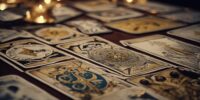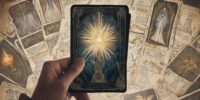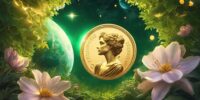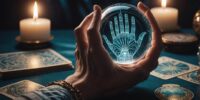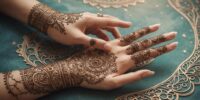What the Artwork of Tarot Reveals About Historical Eras
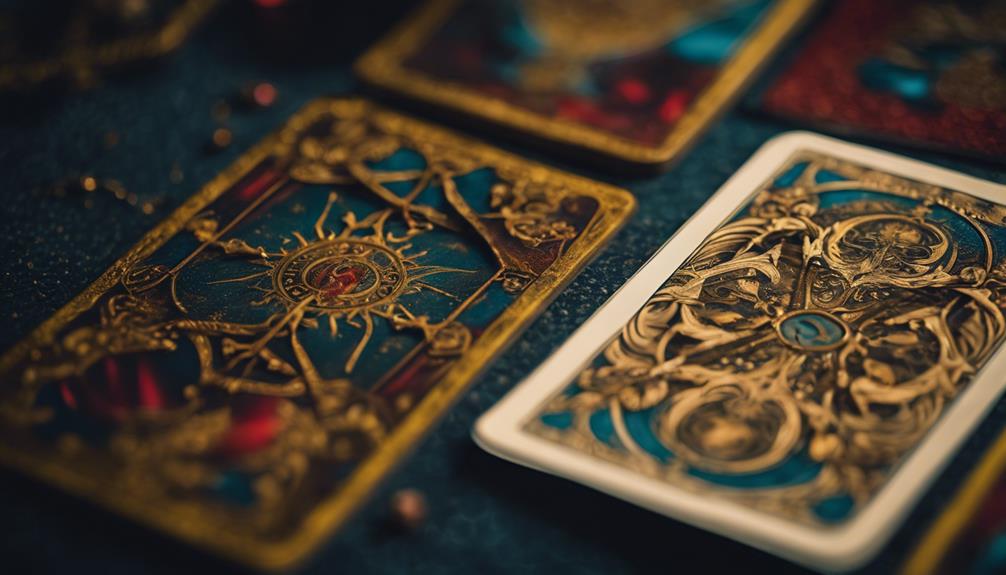
The Artwork of Tarot Cards Reveals Historical Eras through vivid imagery, preserving artistic styles and cultural influences of each era.
Tarot decks offer a glimpse into societal values, beliefs, and aspirations, from the Baroque era to Art Deco aesthetics.
The cards whisper tales of the past, connecting art, history, and the human spirit.
Evolution of Tarot Art Styles
The evolution of Tarot art styles reveals a mesmerizing journey through time, showcasing the intersection of creativity and cultural influences. Within this journey, one can observe the infusion of baroque influences and romantic themes that have left an indelible mark on the Tarot landscape. The baroque era's penchant for intricate details, dramatic lighting, and emotional intensity found a home within Tarot decks, adding a layer of depth and complexity to the artistry.
Romantic themes, with their focus on emotions, nature, and the ethereal, brought a sense of enchantment to Tarot cards, inviting individuals to explore their innermost feelings and desires. The melding of these influences created a tapestry of symbolism and beauty that continues to captivate audiences today.
As Tarot art styles evolved, they not only reflected the artistic trends of their time but also served as a mirror to the values and aspirations of society. Each brushstroke and color choice became a portal to the past, offering a glimpse into the hearts and minds of those who created and cherished these mystical works of art.
Influence of Baroque Era
Reflecting the opulence and drama of the Baroque era, Tarot art styles intricately weave together intricate details and emotional intensity, creating a mesmerizing tapestry of symbolism and beauty. Baroque symbolism and artistry have left an indelible mark on the imagery found in Tarot decks, infusing them with a sense of grandeur and theatricality that captivates the viewer's imagination.
- Dramatic Lighting: Baroque artistry often employed the use of dramatic lighting to create a sense of depth and intensity in paintings. This technique is mirrored in Tarot cards, where shadows and highlights play a significant role in conveying the mood and meaning of each card.
- Rich Symbolism: The Baroque era was characterized by rich symbolism, with artists using allegory and metaphor to communicate complex ideas. Tarot decks influenced by this era are filled with symbols that carry deep meanings, inviting the viewer to contemplate their significance.
- Dynamic Composition: Baroque artists were known for their dynamic compositions, where figures seemed to be in motion, capturing a moment of heightened drama. Tarot cards inspired by this era often feature dynamic poses and intricate scenes that draw the viewer into a world of mystery and intrigue.
Romanticism in Tarot Imagery
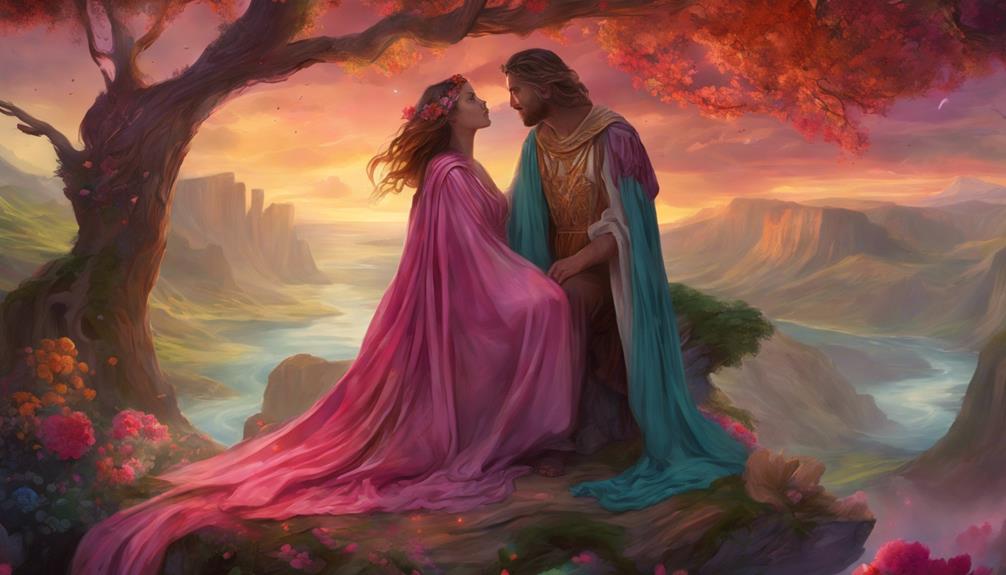
With a delicate brushstroke, Romanticism breathes life into the Tarot imagery, infusing each card with a profound sense of emotional depth and introspection. Symbolism in Romanticism plays a significant role in shaping the visual language of Tarot decks, reflecting the era's emphasis on individualism, nature, and intense emotions. Artists of the Romantic period drew inspiration from folklore, mythology, and the supernatural, infusing their Tarot creations with a sense of mystery and enchantment.
To evoke a sense of emotion in the audience, a table is presented below showcasing the key characteristics of Romanticism in Tarot imagery:
| Emotion | Symbolism | Influence |
|---|---|---|
| Introspection | Moon | Inner emotions |
| Passion | Rose | Love and desire |
| Mystery | Owl | Wisdom and hidden truths |
The Tarot imagery influences from the Romantic era continue to captivate audiences, inviting them to explore the depths of their own emotions and subconscious thoughts through the intricate symbolism woven into each card.
Symbolism of Victorian Era Decks
Drawing inspiration from the opulent aesthetics and societal values of the Victorian era, Tarot decks from this period intricately weave symbolism that reflects the era's fascination with symbolism, morality, and the supernatural. Victorian aesthetics heavily influenced the imagery and themes depicted in Tarot cards from this era.
- Rich Symbolism: Victorian Tarot decks are known for their intricate and elaborate symbols, drawing on the era's love for hidden meanings and allegories.
- Moral Lessons: These decks often incorporated moral lessons and societal norms, reflecting the rigid moral values of the Victorian society.
- Supernatural Elements: The Victorian era was marked by a fascination with the supernatural and occult, leading to the inclusion of mystical and esoteric symbols in Tarot decks of that time.
The historical influences of the Victorian era permeate through these Tarot decks, offering a glimpse into the values, beliefs, and aesthetics of that period. The intricate details and rich symbolism of Victorian era Tarot decks continue to captivate and inspire modern audiences, showcasing a unique blend of artistry and historical significance.
Art Deco Aesthetics in Tarot
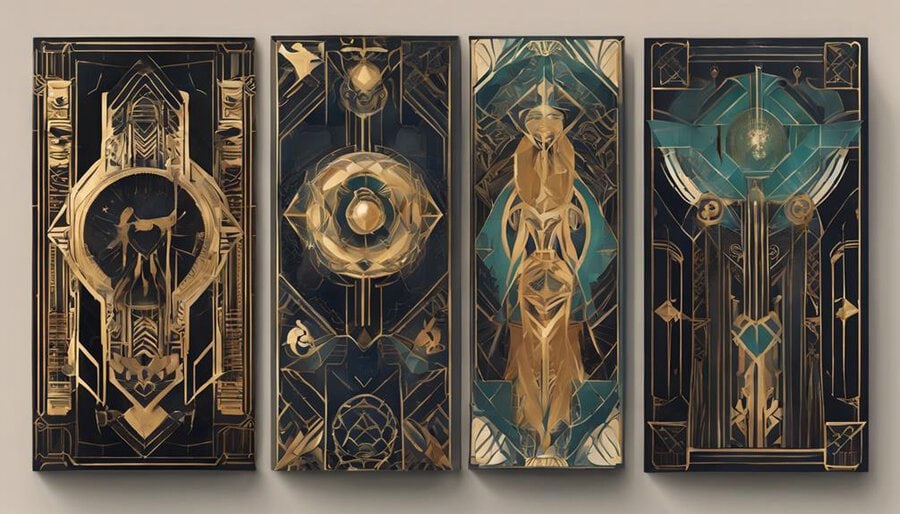
The Art Deco movement of the early 20th century left an indelible mark on the world of design, and Tarot cards were no exception. The sleek lines, geometric shapes, and bold colors of Art Deco aesthetics found their way into the intricate designs of Tarot cards, blending symbolism with modern flair.
Exploring the intersection of Art Deco and Tarot offers a fascinating glimpse into how artistic movements can influence and shape even the most traditional forms of art.
Influence of Art Deco
Art Deco aesthetics gracefully intertwine with the symbolism of Tarot, enriching the visual narrative with a sophisticated blend of geometric patterns and modernist flair.
- Art Deco symbolism brings a sense of luxury and opulence to Tarot cards, elevating their visual appeal.
- The influence of Art Deco on Tarot art introduces clean lines and bold colors that captivate the eye.
- Incorporating Art Deco elements in Tarot designs infuses a sense of glamour and timelessness, adding a modern twist to this ancient divination tool.
The fusion of Art Deco aesthetics with Tarot symbolism creates a harmonious marriage of tradition and modernity, offering a fresh perspective that resonates with those seeking a divination experience rooted in elegance and style.
Symbolism in Art
Enriching the visual tapestry of Tarot with a sophisticated blend of geometric patterns and modernist flair, Art Deco symbolism imbues a sense of luxury and opulence, elevating the cards' aesthetic appeal to new heights. The Art Deco aesthetics in Tarot not only serve as a feast for the eyes but also carry deep symbolic significance.
Each intricate line and bold shape holds layers of meaning waiting for interpretation. The sharp angles and stylized forms in Art Deco Tarot cards symbolize the era's embrace of progress, modernity, and individuality. These symbols invite the viewer to explore beyond the surface, encouraging a deeper connection with the cards and their messages.
The symbolism embedded in Art Deco Tarot art offers a gateway to personal reflection and enlightenment.
Tarot Card Designs
Imbuing Tarot card designs with the luxurious and opulent essence of Art Deco symbolism enhances their aesthetic allure, inviting viewers to unravel layers of meaning through intricate geometric patterns and modernist flair.
Contemporary interpretations infuse Tarot cards with a fresh perspective, incorporating minimalist designs that speak to the essence of the modern era.
Surrealistic influences add a touch of mystery, inviting contemplation of abstract concepts that transcend traditional representations.
Abstract concepts are brought to life through the interplay of form and color, creating a visual language that speaks volumes without uttering a single word.
Tarot Art During World Wars
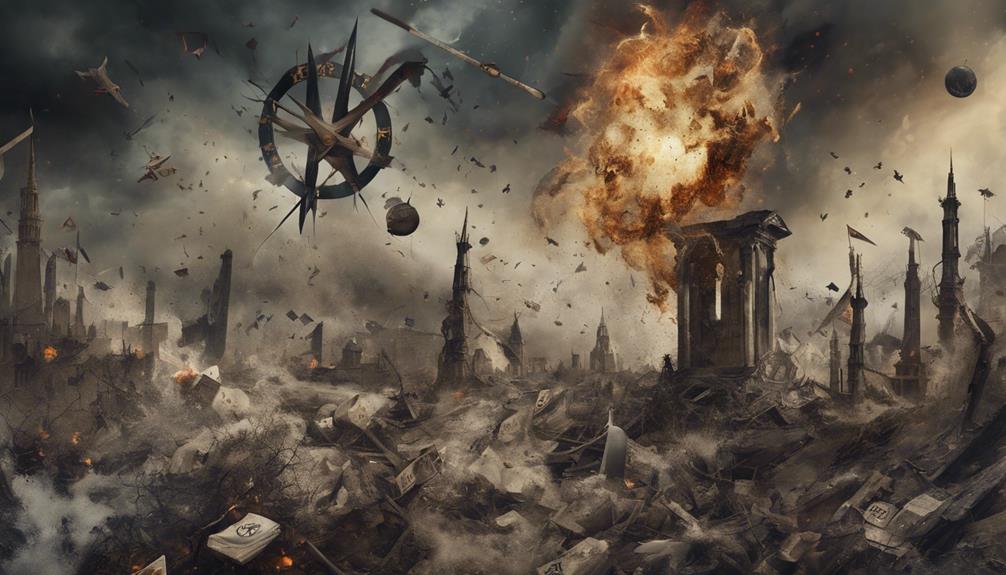
During the World Wars, Tarot artists depicted the tumultuous times through symbolic imagery and intricate designs, capturing the essence of societal upheaval and uncertainty. The impact of these global conflicts on Tarot art was profound, leading to a shift in symbolism and the emergence of new wartime interpretations. The traditional Tarot motifs were infused with elements reflecting the chaos and destruction of war, such as images of soldiers, weapons, and scenes of devastation. The cards themselves took on darker hues, mirroring the somber mood of the era.
Symbolism in Tarot art during the World Wars often focused on themes of loss, resilience, and hope amidst despair. The interpretations of the cards evolved to reflect the challenges faced by individuals living through these turbulent times, offering guidance and solace in the face of uncertainty. Despite the hardships depicted, Tarot art during the World Wars also highlighted the resilience of the human spirit, emphasizing the enduring power of faith and perseverance in the midst of adversity.
Psychedelic Tarot Art of 1960s
In the 1960s, Psychedelic Tarot art burst onto the scene, blending vibrant colors and intricate patterns to reflect the era's countercultural spirit and exploration of consciousness. This unique form of artistry explored into domains of the mind and spirit, mirroring the unconventional and revolutionary attitudes of the time.
- Counterculture Symbolism: Psychedelic Tarot art of the 1960s often incorporated symbols of rebellion, freedom, and non-conformity. These images resonated with individuals seeking to break away from societal norms and embrace alternative ways of thinking and being.
- Vibrant Color Schemes: The use of bright, bold colors in Psychedelic Tarot interpretations symbolized the energy and creativity that characterized the 1960s. These hues evoked a sense of liberation and expansion, encouraging viewers to explore new perspectives and possibilities.
- Intricate Patterns: Elaborate designs and patterns in Psychedelic Tarot art reflected the interconnectedness of all things and the complexity of the human experience. Through these detailed motifs, artists conveyed the idea that reality is multifaceted and ever-changing, inviting viewers to embrace the mysteries of existence with open minds and hearts.
Modern Tarot Art Trends
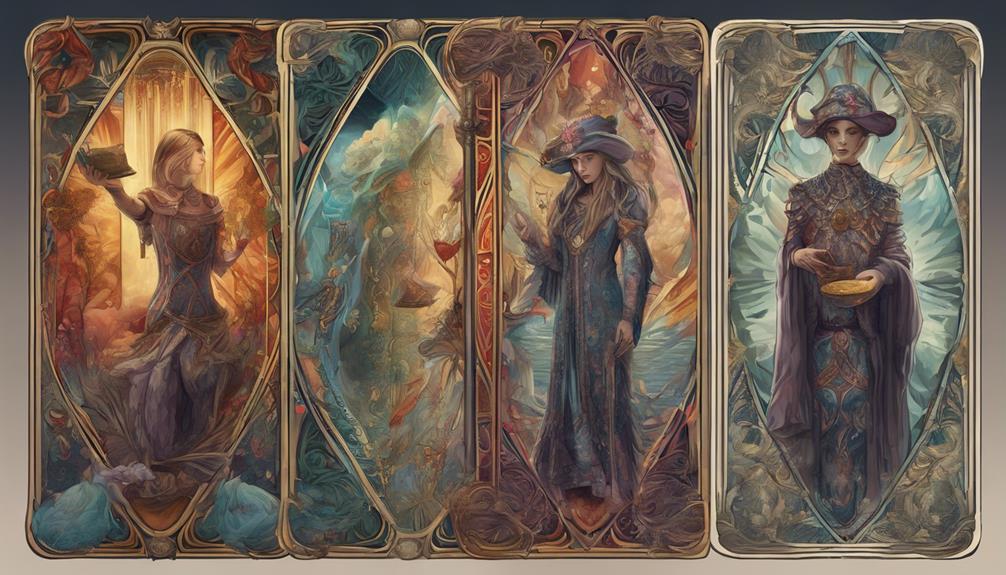
Exploring contemporary artistic expressions, modern Tarot art trends captivate with their fusion of tradition and innovation, inviting viewers to set off on a visual journey through symbolism and imagination. In these modern interpretations, artists blend traditional Tarot symbolism with a fresh perspective, creating decks that resonate with today's audience. One prevalent trend is the rise of minimalist designs, where simplicity and clean lines enhance the timeless meanings of the cards. These contemporary interpretations offer a new take on the classic Tarot structure, appealing to those who seek clarity and simplicity in their readings.
Additionally, surrealistic elements have found their way into modern Tarot art, infusing dreamlike qualities into the cards and inviting deeper introspection. Artists are also drawing inspiration from pop culture influences, incorporating references to modern icons and trends that add a unique twist to the traditional Tarot imagery. By embracing these diverse influences, modern Tarot art continues to evolve, reflecting the ever-changing landscape of art and society.
Frequently Asked Questions
How Has the Evolution of Tarot Art Styles Influenced the Popularity of Tarot Readings Today?
The evolution of symbolism in tarot art styles has greatly influenced the popularity of tarot readings today. Cultural interpretations have broadened, attracting diverse audiences seeking guidance and insight into their lives through this ancient practice.
What Specific Elements of the Baroque Era Can Be Seen in the Artwork of Tarot Cards?
Baroque elegance in tarot cards is evident through opulent details and intricate designs. The artistic symbolism of the Baroque era, like grandeur and drama, is reflected in the rich colors, elaborate patterns, and ornate motifs found in tarot artwork.
How Did Romanticism Influence the Themes and Imagery Found in Tarot Cards?
Romanticism, with its emphasis on emotion and individual experience, greatly influenced the themes and imagery in tarot cards. The movement's focus on nature, mysticism, and the mysterious played a significant role in shaping the symbolic imagery found within the cards.
What Symbols From the Victorian Era Are Commonly Depicted in Tarot Decks and What Do They Represent?
In Tarot decks, Victorian symbols like the rose, key, and clock often appear, each carrying nuanced meanings. Understanding their interpretation provides insight into the era's values and beliefs, offering a glimpse into historical representation.
How Has Modern Technology and Digital Art Impacted the Trends in Modern Tarot Artwork?
Incorporating digital adaptations has revolutionized modern tarot artwork, blending traditional influences with innovative techniques. The fusion allows for broader creative expression, enhancing the depth and diversity of tarot decks in tune with contemporary aesthetics.

